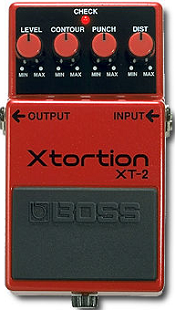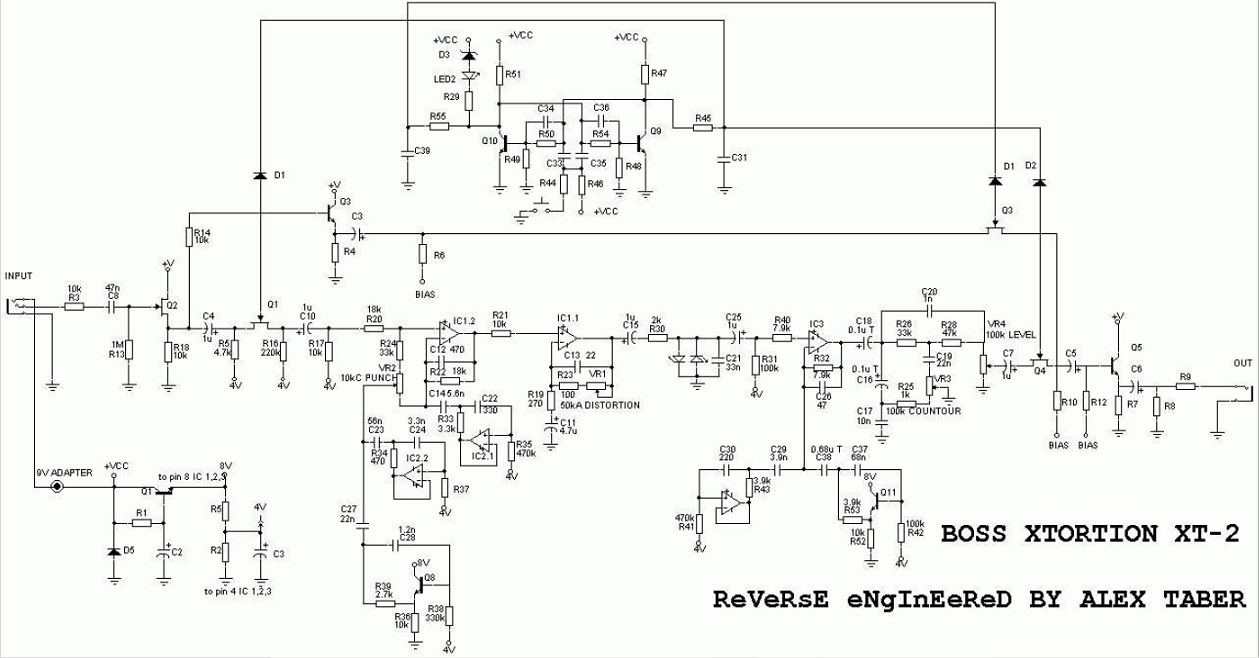Difference between revisions of "XT-2"
m (→General Information) |
|||
| Line 2: | Line 2: | ||
| __TOC__ | | __TOC__ | ||
|} | |} | ||
| − | [[Boss]] XT-2 Xtortion distortion pedal. This is a difficult pedal to get right. It did not approach the production numbers of most of Boss' pedal line. In fact, many lose patience with this pedal and call it "crappy". It was in production from only 1996 to 1998 and the lack of demand (only about 2000 were ever sold) caused Boss to end the pedal. | + | [[Boss]] XT-2 Xtortion distortion pedal. This is a difficult pedal to get right. It did not approach the production numbers of most of Boss' pedal line. In fact, many lose patience with the way that the controls work on this pedal (without adequate explanation by Boss in either the sales literature, or the owner's manual) and end up call it "crappy". It was in production from only 1996 to 1998 and the lack of demand (only about 2000 were ever sold) caused Boss to end the pedal. |
| − | The manner in which | + | The manner in which the XT-2 operates is novel, and we think it's pretty clear that Boss did a poor to non-existent job of explaining how the controls work. Those who purchased and used the pedal were usually unaware of how to use it and as a result, more often than not, were disappointed by the outcome. We hope this wiki page helps dispel some confusion. |
As described above, the Boss XT-2 Xtortion is no longer being made. | As described above, the Boss XT-2 Xtortion is no longer being made. | ||
| − | * '''Thermionic Studios has one(1) Boss XT-2 Xtortion available for rental''' | + | * '''Thermionic Studios has one(1) Boss XT-2 Xtortion pedal available for rental''' |
==Controls== | ==Controls== | ||
| Line 62: | Line 62: | ||
|} | |} | ||
| − | There is a second "Q3" connected to the emitter of the actual Q3. This second Q3 can be found on the right side of the schematic. This transistor should be "Q6" and all subsequent transistors (Q8 thru Q11) should be renumbered accordingly (Q7 to Q10). | + | There is a second "Q3" connected to the emitter of the actual Q3. This second Q3 can be found on the right side of the schematic. This transistor should be "Q6" and all subsequent transistors (Q8 thru Q11) should be renumbered accordingly (Q7 to Q10). Also please note there is a second "Q1" that is used in the power rail, and also doesn't seem to be included in the component numbering on the schematic. |
| + | |||
| + | Finally, please also note that Q2 and Q5 (as labeled on the schematic) are buffer transistors, and that Q3 (and the other Q3), along with Q9 and Q10, are part of the silent switching apparatus that Boss always includes in their pedals and really isn't germane to the function of the XT-2. In other words, these portions of the XT-2 could be stripped away, and the pedal would still function. | ||
==Schematic== | ==Schematic== | ||
Revision as of 20:20, 28 December 2019
Boss XT-2 Xtortion distortion pedal. This is a difficult pedal to get right. It did not approach the production numbers of most of Boss' pedal line. In fact, many lose patience with the way that the controls work on this pedal (without adequate explanation by Boss in either the sales literature, or the owner's manual) and end up call it "crappy". It was in production from only 1996 to 1998 and the lack of demand (only about 2000 were ever sold) caused Boss to end the pedal.
The manner in which the XT-2 operates is novel, and we think it's pretty clear that Boss did a poor to non-existent job of explaining how the controls work. Those who purchased and used the pedal were usually unaware of how to use it and as a result, more often than not, were disappointed by the outcome. We hope this wiki page helps dispel some confusion.
As described above, the Boss XT-2 Xtortion is no longer being made.
- Thermionic Studios has one(1) Boss XT-2 Xtortion pedal available for rental
Controls

- Knob 1 - "Level": controls the volume output level of your guitar signal.
- Knob 2 - "Contour": adjusts the frequency that gets cut or boosted. Fully counter-clockwise is bass frequencies, fully clockwise is treble frequencies.
- Knob 3 - "Punch": adjusts the level of the frequency selected by the Contour control. Fully counter-clockwise cuts; fully clockwise boosts.
- Knob 4 - "Dist": controls distortion gain from moderate to extreme.
- Footswitch - "On/Off": Toggles the pedal on and off.
Bypass:Buffered
Like all Boss pedals, the XT-2 has a buffered bypass.
General Information
So we equate the operation of the XT-2 Xtortion as a distortion pedal plus a fixed wah-wah filter that is set by the contour and punch controls. It's easy to think of the Xtortion as a distortion pedal hooked into an MXR QZone pedal. The biggest clue as to it operating in such a manner is the "Fixed Wah" setting, shown on page 13 of the Owner's Manual.
If we look at the schematic, it seems like it would be a bit odd to describe the tone stack "like a fixed wah" because the topology of the schematic doesn't follow the typical schematic for a wah-wah. However, we also need to recognize that the usual wah-wah pedal with an inductor ([Vox] or [Crybaby]) is only the most well-known because it was the first and the most copied. If we look at the TycoBrahe Parachute Wah, we see something entirely different: a wah-wah pedal powered by integrated circuits (ICs) and no inductor. So the topology can make a bit more sense when we also realize that we don't just have a fixed wah, but a fixed wah-style tone control combined with a distortion circuit.
Because of the negative opinion many people have of this pedal, it is a candidate for the Bad Device Chain Challenge.
Pedal Manual
Phase Inversion: No
We don't see any electronic components aligned in this schematic that would inverse phase, so we currently declare this pedal as not inverting phase. Of course this will have to be put on an oscilliscope to verify real-world results.
| Schematic ID | Electronic Part | Action | Phase State |
|---|---|---|---|
| Q2 | - | Does not Invert | Original |
| Q1 | - | Does not Invert | Original |
| IC2.2 | - | Does not Invert | Original |
| IC2.1 | - | Does not Invert | Original |
| IC1.2 | - | Does not Invert | Original |
| IC1.1 | - | Does not Invert | Original |
| IC3.1 | - | Does not Invert | Original |
| IC3.2 | - | Does not Invert | Original |
| Q11 | - | Does not Invert | Original |
| Q4 | - | Does not Invert | Original |
| Q5 | - | Does not Invert | Original |
There is a second "Q3" connected to the emitter of the actual Q3. This second Q3 can be found on the right side of the schematic. This transistor should be "Q6" and all subsequent transistors (Q8 thru Q11) should be renumbered accordingly (Q7 to Q10). Also please note there is a second "Q1" that is used in the power rail, and also doesn't seem to be included in the component numbering on the schematic.
Finally, please also note that Q2 and Q5 (as labeled on the schematic) are buffer transistors, and that Q3 (and the other Q3), along with Q9 and Q10, are part of the silent switching apparatus that Boss always includes in their pedals and really isn't germane to the function of the XT-2. In other words, these portions of the XT-2 could be stripped away, and the pedal would still function.
Schematic
Artists
We are currently unaware of any artists actively using the pedal now, or who have in the past.
- Additional Sources
